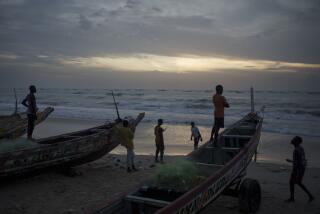Migrant arrivals in Europe decrease in 2020, but deaths at sea remain high

- Share via
BARCELONA, Spain — The number of migrants and asylum-seekers who reached Europe in 2020 is the lowest it has been in the last decade, according to a report released Friday by the United Nations migration agency. But deaths and disappearances on sea routes remain alarmingly high, with only a small fraction of bodies recovered and victims identified.
Of the 93,000 people who entered Europe irregularly last year, about 92% did so via the western, central and eastern Mediterranean Sea, as well as through the Atlantic Ocean off West Africa to Spain’s Canary Islands, often on unseaworthy boats.
Arrivals in the Canaries, considered part of the European Union’s free-travel Schengen area, increased by 750% last year. The numbers had already picked up before the COVID-19 pandemic following tougher border controls and interceptions on the Mediterranean by North African countries, but the pandemic seems to have “acted as a multiplier of existing factors motivating migration on this route,” the report said.
It added that many migrants previously worked in sectors such as fishing and agriculture that have suffered greatly from the economic consequences of the pandemic.
The sea routes are lethal. The International Organization for Migration’s Missing Migrants Project has confirmed the death or disappearances of at least 2,300 people last year. This number is higher than in 2019, when 2,095 victims were recorded and slightly lower than in 2018, which had 2,344.
The central Mediterranean north of Libya saw 984 people perish in 2020. Meanwhile, on the Atlantic route to the Canaries, at least 849 victims were recorded — more than four times as many as in any previous year, according to the U.N. agency’s report.
During Europe’s 2015 migrant crisis, Germany took in more than 1 million newcomers, sparking a backlash by some. Five years on, tensions have eased.
But the organization admits its data are incomplete. So-called “invisible shipwrecks,” when entire boats disappear and leave no survivors, are especially concerning, the report said.
In 2020, there were at least 19 cases of invisible shipwrecks in the Atlantic and Mediterranean, with 571 people reported missing, according to IOM data requested by the Associated Press.
“Such cases are extremely difficult to detect, let alone verify, and are yet another indication that the true number of deaths on maritime routes to Europe is far higher than indicated by the available data,” the report said.
The AP has most recently come across an example of uncounted deaths after interviewing two survivors who reached the Canary Islands last November. According to them, more than 20 people on their boat did not survive the two-week odyssey.
Hundreds of migrant families, including babies and pregnant women, were detained under the Anzalduas International Bridge, sleeping in the dirt, without much food or medical care, people who were released said.
The group of about 180 people had departed from the town of Joal-Fadiouth in Senegal but ran out of food, water and fuel after the eighth day.
“It was horrible,” said Babacar Mboup, a former fisherman who was among them. “I saw people dying by my side.”
Their bodies were thrown overboard after they died.
A Spanish rescue helicopter finally spotted the boat drifting 33 miles from the island of El Hierro. When rescuers reached the 158 survivors, only one body remained on the boat. Fearing backlash, those alive did not tell authorities that another 20 people were in the ocean, so only one death was recorded.
Mboup said he did not know most of those who died but had alerted the family of one of the deceased whom he did know. His name was Lamine, and he was 28 years old.
More to Read
Sign up for Essential California
The most important California stories and recommendations in your inbox every morning.
You may occasionally receive promotional content from the Los Angeles Times.











